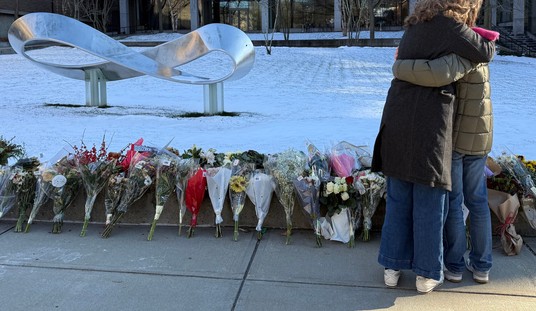In a recent article, we considered the claims of Brittney Cooper, a professor at Rutgers University. She believes that all “white people,” whom she also refers to as “motherf***ers” who are “committed to being villains” — in a word, racists — need to be “taken out.”
[Sign the petition to fire Cooper for her racist and divisive remarks here.]
One of her arguments is that whenever non-whites try to have a “reckoning” with whites, the latter say, “It’s just human nature. If y’all had all of this power, you would have done the same thing,” right?
To this, Cooper insists,
No, that’s what white humans did, white human beings thought there’s a world here and we own it. Prior to them, black and brown people have been sailing across oceans, interacting with each other for centuries without total subjugation, domination and colonialism, right?
This must be the professor’s most ignorant of claims — which is saying much — that non-whites somehow behaved with more tolerance and civility whenever they landed on the shores of others.
While we don’t necessarily have historical records of black sub-Saharans “sailing across oceans,” we do know that they savagely warred on and enslaved one another. It is enough to point that out, as Michael Omolewa, a Nigerian diplomat, once did:
[T]he bulk of the supply [of African slaves sold to Europeans] came from the Nigerians. These Nigerian middlemen moved to the interior where they captured other Nigerians who belonged to other communities. . . . Many Nigerian middlemen began to depend totally on the slave trade and neglected every other business and occupation. The result was that when the trade was abolished [by England in 1807] these Nigerians began to protest. As years went by and the trade collapsed such Nigerians lost their sources of income and became impoverished.
These are not just historical observations. Despite Western efforts to abolish slavery, there are currently more than 50 million slaves—all of them in the non-Western world. To quote from one report,
As the world marks 400 years since the first recorded African slaves arrived in North America, slavery remains a modern-day scourge…. Africa has the highest prevalence of slavery, with more than seven victims for every 1,000 people.
Even the overly romanticized American Indians engaged in “total subjugation and domination”:
Long before Columbus, many historians agree that Native American tribes committed atrocities against each other, thirsting for power and land and killing anyone that stood in the way long before any European settler set foot on the continent.
More to the point, we have multiple examples of what non-whites did after landing on the shores of whites — and centuries before the transatlantic slave trade began.
In 711, for example, hordes of African Muslims (“Moors,” which came to mean dark-skinned or black Muslims) “godlessly invaded Spain to destroy it,” to quote from the Chronicle of 754. They did not pass “a place without reducing it, and getting possession of its wealth,” boasted al-Hakam, an early Muslim chronicler, “for Allah Almighty had struck with terror the hearts of the infidels.” One year later, the Muslims had, the Chronicle of 754 continues, “ruined beautiful cities, burning them with fire; condemned lords and powerful men to the cross; and butchered youths and infants with the sword.”
Several other early sources corroborate the devastation and persecution. The oldest account, the Tempore belli, tells of Muslims from Africa “sacking Christian temples [churches] and homes, burning the cities of those who resisted, and taking their young women as sexual slaves, all creating an indescribable terror.”
In 715, after the Muslim conquest of Spain was complete, its generals made the long trip to the Umayyad caliphate in Damascus. They brought with them thousands of camels laden with immense treasures and thirty thousand captives as a flesh-tribute to Caliph Al-Walid, who, according to al-Maqqari, the Arab chronicler, was delighted by “the resources of all the people of Spain… its riches and the beauty of its young girls.”
Thereafter, and because the “Umayyads particularly valued blond or red-haired Franc or Galician women as sexual slaves,” writes historian Dario Fernandez-Morera, “al-Andalus [Muslim-controlled Spain] became a center for the trade and distribution of slaves” [“The Myth of the Andalusian Paradise,” p. 159]. Christian subjects were sometimes even required to make an annual tribute “not of money, or horses, or arms, but of a hundred damsels (all to be distinguished for beauty) to ornament the harems” [“Spain and Portugal,” p. 132].
TheMoorish conquest of Spain — and depredations deep into France, where tens of thousands of more Europeans were slaughtered and enslaved in the years leading up to the Battle of Tours, 732 — is just one example of what “black and brown people,” to use Ms. Cooper’s terminology, did to “white humans,” centuries before the transatlantic slave trade.
One can give many more examples. Consider what the Turks, who migrated from the eastern steppes of Asia, did to and in Europe. In the years preceding the First Crusade, Turkish invaders were running amok in Asia Minor, formerly a bastion of Christianity (now “Turkey”). An anonymous Georgian chronicler wrote of how “holy churches served as stables for their horses,” the “priests were immolated during the Holy Communion itself,” the “virgins defiled, the youths circumcised, and the infants taken away.” Similarly, Anna Comnena, the princess at Constantinople, wrote of how “cities were obliterated, lands were plundered, and the whole of Anatolia was stained with Christian blood.”
Centuries later, in 1438, Bartolomeo de Giano, an Italian Franciscan who was holed up in Constantinople as the Turks laid siege to it, described their slave raids throughout the Balkans. From Hungary, 300,000 were enslaved and “carried off in just a few days,” he wrote; from Serbia and Transylvania, 100,000 were “led away in iron fetters tied to the backs of horses… [and] women and children were herded by dogs without any mercy or piety. If one of them slowed down, unable to walk further because of thirst or pain, O Good Jesus! she immediately ended her life there in torment, cut in half.”
As one historian observes, “[t]he massive enslavement of slavic populations during this period gave rise, in fact, to our word ‘slave’: in Bartolomeo’s time, to be a slave was to be a Slav.”
The slave markets of the Ottoman sultanate were for centuries so inundated with European flesh that children sold for pennies, “a very beautiful slave woman was exchanged for a pair of boots, and four Serbian slaves were traded for a horse.”
It was the same elsewhere. In Crimea — where many millions of Slavs were enslaved by the Ottomans’ Muslim allies, the Tatars (Mongols turned Muslim) — an eyewitness described how Christian men were castrated and savagely tortured (including by gouging out their eyes), whereas “[t]he youngest women are kept for wanton pleasures.”
As for the Moors, even after being ejected out of Spain and back to North Africa (or Barbary), they continued raiding virtually every corner of Europe — going as far as Britain, Ireland, Denmark, and Iceland in search of plunder and slaves. These raids were so successful that “between 1530 and 1780[,] there were almost certainly a million and quite possibly as many as a million and a quarter white, European Christians enslaved by the Muslims of the Barbary Coast,” to quote American historian Robert Davis.
With countless European women selling for the “price of an onion,” it’s little wonder that by the late 1700s, European observers noted how “the inhabitants of Algiers have a rather white complexion.”
Then there was the abysmal treatment meted out to European slaves. As Robert Playfair (b.1828), who served for years as a consul in Barbary, explained, “[i]n almost every case they [European slaves] were hated on account of their religion.” Three centuries earlier, John Foxe (b.1516) had written in his “Book of Martyrs” that “[i]n no part of the globe are Christians so hated, or treated with such severity, as at Algiers.”
The punishments these European slaves received for real or imagined offenses beggared description:
If they speak against Mahomet [blasphemy], they must become Mahometans, or be impaled alive. If they profess Christianity again, after having changed to the Mahometan persuasion, they are roasted alive [as apostates], or thrown from the city walls, and caught upon large sharp hooks, on which they hang till they expire.
These are just a very few examples to counter Professor Cooper’s assertion:
Prior to them [whites], black and brown people have been sailing across oceans, interacting with each other for centuries without total subjugation, domination and colonialism, right?
Wrong — abysmally so.










Join the conversation as a VIP Member